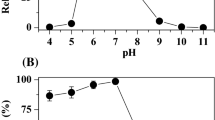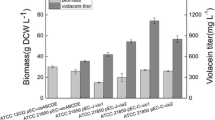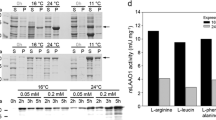Abstract
Objective
To examine the role of a gene encoding flavin-containing monooxygenase (cFMO) from Corynebacterium glutamicum ATCC13032 when cloned and expressed in Escherichia coli for the production of indigo pigments.
Results
The blue pigments produced by recombinant E. coli were identified as indigo and indirubin. The cFMO was purified as a fused form with maltose-binding protein (MBP). The enzyme was optimal at 25 °C and pH 8. From absorption spectrum analysis, the cFMO was classified as a flavoprotein. FMO activity was strongly inhibited by 1 mM Cu2+ and recovered by adding 1–10 mM EDTA. The enzyme catalyzed the oxidation of TMA, thiourea, and cysteamine, but not glutathione or cysteine. MBP-cFMO had an indole oxygenase activity through oxygenation of indole to indoxyl. The recombinant E. coli produced 685 mg indigo l−1 and 103 mg indirubin l−1 from 2.5 g l-tryptophan l−1.
Conclusion
The results suggest the cFMO can be used for the microbial production of both indigo and indirubin.





Similar content being viewed by others
References
Cashman JR (1995) Structural and catalytic properties of the mammalian flavin-containing monooxygenase. Chem Res Toxicol 8:166–181
Cashman JR (2005) Some distinctions between flavin-containing and cytochrome P450 monooxygenases. Biochem Biophys Res Commun 338:599–604
Cho HJ, Cho HY, Kim KJ, Kim MH, Kim SW, Kang BS (2011) Structural and functional analysis of bacterial flavin-containing monooxygenase reveals its ping-pong-type reaction mechanism. J Struct Biol 175:39–48
Choi HS, Kim JK, Cho EH, Kim YC, Kim JI, Kim SW (2003) A novel flavin-containing monooxygenase from Methylophaga sp. strain SK1 and its indigo synthesis in Escherichia coli. Biochem Biophys Res Commun 306:930–936
Eisenbrand G, Hippe F, Jakobs S, Muehlbeyer S (2004) Molecular mechanisms of indirubin and its derivatives: novel anticancer molecules with their origin in traditional Chinese phytomedicine. J Cancer Res Clin Oncol 130:627–635
Ensley BD, Ratzkin BJ, Osslund TD, Simon MJ, Wackett LP, Gibson DT (1983) Expression of naphthalene oxidation genes in Escherichia coli results in the biosynthesis of indigo. Science 222:167–169
Fraaije MW, Kamerbeek NM, van Berkel WJ, Janssen DB (2002) Identification of a Baeyer-Villiger monooxygenase sequence motif. FEBS Lett 518:43–47
Han GH, Shin HJ, Kim SW (2008) Optimization of bio-indigo production by recombinant E. coli harboring fmo gene. Enzyme Microb Technol 42:617–623
Han GH, Bang SE, Babu BK, Chang M, Shin HJ, Jim SW (2011) Bio-indigo production in two different fermentation systems using recombinant Escherichia coli cells harboring a flavin-containing monooxygenase gene (fmo). Process Biochem 46:788–791
Han GH, Gim GH, Kim W, Seo SI, Kim SW (2012) Enhanced indirubin production in recombinant Escherichia coli harboring a flavin-containing monooxygenase gene by cysteine supplementation. J Biotechnol 164:179–187
Kang MS, Lee JH (2009) Cloning and expression of indole oxygenase gene derived from Rhodococcus sp. RHA1. Kor J Microbiol Biotechnol 37:197–203
Kleiger G, Eisenberg D (2002) GXXXG and GXXXA motifs stabilize FAD and NAD(P)-binding Rossmann folds through Cα–H···O hydrogen bonds and van der Waals interactions. J Mol Biol 323:69–76
Lee J (2014) Development and characterization of expression vectors for Corynebacterium glutamicum. J Microbiol Biotechnol 24:70–79
Lee JY, Shin YS, Shin HJ, Kim GJ (2011) Production of natural indirubin from indican using non-recombinant Escherichia coli. Bioresour Technol 102:9193–9198
Lim HK, Chung EJ, Kim JC, Choi GJ, Jang KS, Chung YR, Cho KY, Lee SW (2005) Characterization of a forest soil metagenome clone that confers indirubin and indigo production on Escherichia coli. Appl Environ Microbiol 71:7768–7777
Lomri N, Gu Q, Cashman JR (1992) Molecular cloning of the flavin-containing monooxygenase (form II) cDNA from adult human liver. Proc Natl Acad Sci USA 89:1685–1689
Lu Y, Mei L (2007) Co-expression of P450 BM3 and glucose dehydrogenase by recombinant Escherichia coli and its application in an NADPH-dependent indigo production system. J Ind Microbiol Biotechnol 34:247–253
Moon MJ, Lee SK, Lee JW, Song WK, Kim SW, Kim JI, Cho C, Choi SJ, Kim YC (2006) Synthesis and structure-activity relationships of novel indirubin derivatives as potent anti-proliferative agents with CDK2 inhibitory activities. Bioorg Med Chem 14:237–246
Singh A, Singh Chauhan N, Thulasiram HV, Taneja V, Sharma R (2010) Identification of two flavin monooxygenases from an effluent treatment plant sludge metagenomic library. Bioresour Technol 101:8481–8484
Suh JK, Poulsen LL, Ziegler DM, Robertus JD (1996) Molecular cloning and kinetic characterization of a flavin-containing monooxygenase from Saccharomyces cerevisiae. Arch Biochem Biophys 336:268–274
van Berkel WJ, Kamerbeek NM, Fraaije MW (2006) Flavoprotein monooxygenases, a diverse class of oxidative biocatalysts. J Biotech 124:670–689
Acknowledgments
This research was supported by Basic Science Research Program through the National Research Foundation of Korea (NRF) funded by the Ministry of Education, Science and Technology (NRF-2012R1A1A2007229).
Supporting information
Supplementary Table 1—The bacterial strains and plasmids used in this study.
Supplementary Figure 1—Effect of pH (a) and temperature (b) on the NADPH oxidase activity of purified MBO-Cfmo.
Supplementary Figure 2—Absorption spectra of purified MBP-cFMO.
Author information
Authors and Affiliations
Corresponding author
Electronic supplementary material
Below is the link to the electronic supplementary material.
Rights and permissions
About this article
Cite this article
Ameria, S.P.L., Jung, H.S., Kim, H.S. et al. Characterization of a flavin-containing monooxygenase from Corynebacterium glutamicum and its application to production of indigo and indirubin. Biotechnol Lett 37, 1637–1644 (2015). https://doi.org/10.1007/s10529-015-1824-2
Received:
Accepted:
Published:
Issue Date:
DOI: https://doi.org/10.1007/s10529-015-1824-2




